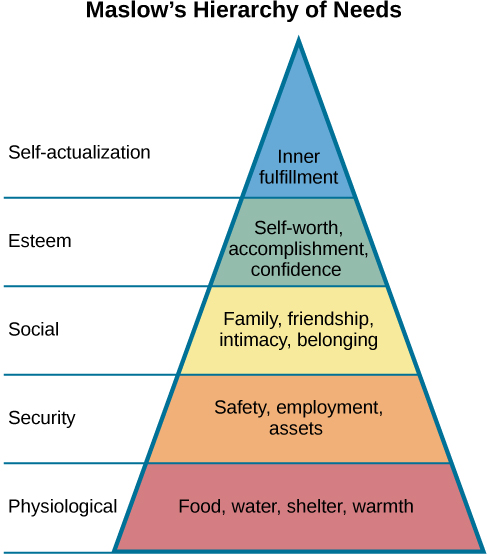20 Basic Human Needs
Alexandria Lewis
I. Human Development, Diversity, and Behavior in the Environment
IA. Human Growth and Development
KSAs: Basic human needs
Overview
Source of the following content: 15.6: Maslow’s Hierarchy of Needs is shared under a not declared license and was authored, remixed, and/or curated by LibreTexts.
While the theories of motivation described earlier relate to basic biological drives, individual characteristics, or social contexts, Abraham Maslow (1943) proposed a hierarchy of needs that spans the spectrum of motives ranging from the biological to the individual to the social. These needs are often depicted as a pyramid. Maslow’s hierarchy of needs is illustrated below. In some versions of the pyramid, cognitive and aesthetic needs are also included between esteem and self-actualization. Others include another tier at the top of the pyramid for self-transcendence.
At the base of the pyramid are all the physiological needs necessary for survival. These are followed by basic needs for security and safety, the need to be loved and to have a sense of belonging, and the need to have self-worth and confidence. The top tier of the pyramid is self-actualization, which is a need that essentially equates to achieving one’s full potential, and it can only be realized when needs lower on the pyramid have been met. To Maslow and humanistic theorists, self-actualization reflects the humanistic emphasis on positive aspects of human nature. Maslow suggested that this is an ongoing, life-long process and that only a small percentage of people achieve self-actualization.

According to Maslow, one must satisfy lower-level needs before addressing those needs that occur higher in the pyramid. So, for example, if someone is struggling to find enough food to meet his nutritional requirements, it is quite unlikely that he would spend an inordinate amount of time thinking about whether others viewed him as a good person or not. Instead, all of his energies would be geared toward finding something to eat.
Resource: The Blackfoot Wisdom that Inspired Maslow’s Hierarchy.
However, it should be pointed out that Maslow’s theory has been criticized for its subjective nature and its inability to account for phenomena that occur in the real world. Other research has more recently addressed that late in life, Maslow proposed a self-transcendence level above self-actualization—to represent striving for meaning and purpose beyond the concerns of oneself. For example, people sometimes make self-sacrifices to make a political statement or in an attempt to improve the conditions of others. For another example, some people may engage in hunger strikes or otherwise put themselves in danger by displaying higher-level motives beyond their own needs.
Definitions
Hierarchy of needs: spectrum of needs ranging from basic biological needs to social needs to self-actualization
Motivation: wants or needs that direct behavior toward some goal
Self-efficacy: individual’s belief in his own capabilities or capacities to complete a task

